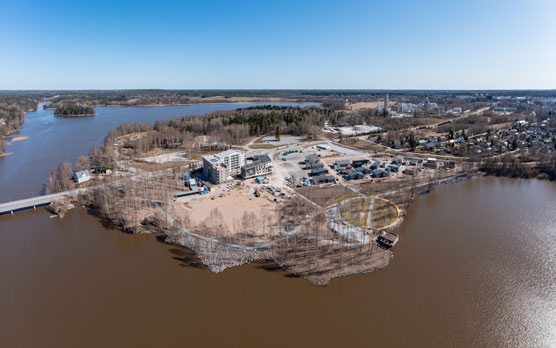
© The City of Lohja
Press release of City of Lohja, 12 May 2021
Lohja has decided to calculate the carbon footprint and carbon handprint of the houses in the Housing Fair area. For the first time, the Ministry of the Environment's updated low-carbon assessment method for buildings is in use. The comprehensive reform of the Land Use and Building Act is making it compulsory to calculate the carbon footprint of construction projects by 2025.
“Already during the construction phase, we instructed construction projects to take the climate perspective into account. Now we want to make the climate impacts of different choices visible through carbon footprint calculation”, says Mirka Härkönen, Project Manager at Lohja Housing Fair.
Architect Matti Kuittinen has been part of a working group developing the Calculation Model of the Ministry of the Environment. In addition, he is the designer of one of the Lohja Housing Fair houses.
“In Lohja, the updated low-carbon assessment method is in use for the first time. Traditionally, the heating of a building accounts for a large part of the carbon footprint, but emissions from heating are generated in the long term. However, buildings are becoming increasingly energy-efficient, which means that the emissions of materials from the construction phase will play a significant role.”
The Ministry of the Environment has prepared a low-carbon assessment method for buildings. It allows the climate impacts of construction to be calculated throughout the building's life cycle, from the manufacture of construction products to transport and site operations, use and repairs, demolition, and recycling. Last summer, the first version of the assessment method was tested at the Housing Fair in Tuusula. Lohja will now have access to a new updated version of the tool for calculations on houses in the Housing Fair area. Granlund Oy was chosen as the implementer of the calculations.
Lohja is involved in the national CANEMURE - Towards Carbon Neutral Municipalities and Regions project, partly funded by the EU's LIFE programme and coordinated by the Finnish Environment Institute. In Lohja, the project has meant mitigating the climate impacts of construction, housing and traffic in the Housing Fair area in Hiidensalmi.
Jenna Kotilehto, project coordinator for the CANEMURE project, sums up the importance of carbon footprint calculation for the average consumer:
“In the future, monitoring the carbon footprint during the planning phase of the construction project will enable builders to make better choices for the climate in their building projects. Now we want to make the carbon footprint calculation of buildings known and illustrate the impact of different construction solutions on the emissions of the entire life cycle of the building. At the same time, the importance of construction solutions is compared to everyday activities such as driving, travelling by air or, for example, going to sauna.”
In 2020, the Finnish Housing Fair carried out an extensive study on the ideals of Finnish housing. The research was based on a desire to understand how housing should develop to correspond sufficiently to the residents' perspective represented at the Housing Fair.
According to the study, the emphasis on eco-friendliness discussed in public debate so far is reflected in only a few housing solutions. Eco-friendliness is considered important, but it does not yet have a significant impact on housing choices. Some European countries, such as the Netherlands and France, already have regulation in place on emissions during the life cycle of buildings or emissions of building materials. Mandatory carbon footprint calculations are also planned in Finland as part of the overall reform of the Land Use and Building Act.
Further information
Carbon footprint calculations: Project coordinator Jenna Kotilehto, +358 44 369 4488 and Project Manager Mirka Härkönen, +358 50 590 8020, City of Lohja